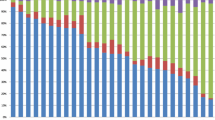Abstract
Mobile number portability (MNP), which allows consumers to retain their mobile numbers when switching service providers, is expected to promote competition by lowering switching costs. This paper estimates switching costs and switching costs reduction from the MNP policy in Thailand using the mixed logit model with preference heterogeneity on a nationwide survey of mobile telecommunications service usages. The estimation result shows that the MNP policy reduces switching costs by 37% on average and that this benefit is heterogeneous across consumers. The considerable and persistent switching costs call for additional measures to facilitate switching.




Similar content being viewed by others
Notes
The average marginal effect is estimated using the logit model of switching decision with the following independent variables: MNP dummy variable, previous service provider dummy variables, age, age squared, income, income squared, education dummy variables, and quadratic trend.
The models can also be estimated with conditional logits but Hausman–McFadden test rejects the null hypothesis of IIA property. The mixed logit model is used to allow a violation of the IIA property.
One may restrict the price coefficient to be negative using the log-normal distribution. However, even with the assumption of normality, the estimated distribution is practically one-sided as shown in Fig. 4c. Besides, the log-normal specification yields only slightly smaller switching costs and switching costs reduction in compensating variation terms. Thus, the main conclusions remain the same.
The figure shows kernel density estimates of the conditional distributions simulated with the method developed by Revelt and Train (2000) with 500 draws. Bandwidths for switching costs, switching costs reduction and price coefficient are 0.5, 0.1 and 0.0002 respectively.
References
Ausubel, L. M. (1991). The failure of competition in the credit card market. American Economic Review, 81(1), 50–81.
Bhat, C. R. (2001). Quasi-random maximum simulated likelihood estimation. Transportation Research Part B: Methodological, 35(7), 677–693.
Buehler, S., Dewenter, R., & Haucap, J. (2006). Mobile number portability in Europe. Telecommunications Policy, 30(7), 385–399.
Czajkowski, M., & Sobolewski, M. (2016). How much do switching costs and local network effects contribute to consumer lock-in in mobile telephony? Telecommunications Policy, 40(9), 855–869.
Farrell, J., & Klemperer, P. (2007). Coordination and lock-in: Competition with switching costs and network effects. In M. Armstrong & R. H. Porter (Eds.), Handbook of industrial organization (Vol. 3, pp. 1967–2072). Amsterdam: Elsevier.
Grzybowski, L. (2008). Estimating switching costs in mobile telephony in the UK. Journal of Industry, Competition and Trade, 8(2), 113–132.
Hole, A. R. (2007). Estimating mixed logit models using maximum simulated likelihood. The Stata Journal, 7(3), 388–401.
Ida, T., & Kuroda, T. (2009). Discrete choice model analysis of mobile telephone service demand in Japan. Empirical Economics, 36, 65–80.
Kim, J. (2012). Consumers’ dynamic switching decisions in the cellular service industry. NET institute working paper no. 06-24.
Kitano, T., & Ohashi, H. (2014). Heterogeneous switching costs and number portability: Japanese mobile telecommunications. Working paper.
Knittel, C. R. (1997). Interstate long distance rates: Search costs, switching costs, and market power. Review of Industrial Organization, 12, 519–536.
Lee, J., Kim, Y., Lee, J.-D., & Park, Y. (2006). Estimating the extent of potential competition in the Korean mobile telecommunications market: Switching costs and number portability. International Journal of Industrial Organization, 24, 107–124.
Lyons, S. (2010). Measuring the effects of mobile number portability on service prices. Journal of Telecommunications Management, 2(4), 357–368.
Maicas, J. P., Yolanda, P., & Sese, J. F. (2009). Reducing the level of switching costs in mobile communications: The case of mobile number portability. Telecommunications Policy, 33, 544–554.
McFadden, D. (1974). Conditional logit analysis of qualitative choice behaviour. In P. Zarembka (Ed.), Frontiers in Econometrics (pp. 105–142). New York: Academic Press.
Park, M. (2011). The economic impact of wireless number portability. Journal of Industrial Economics, 59(4), 714–745.
Revelt, D., & Train, K. (2000). Customer-specific taste parameters and mixed logit: Households’ choice of electricity supplier. Working paper, 2000: Department of Economics, University of California, Berkeley.
Sharpe, S. A. (1997). The effect of consumer switching costs on prices: A theory and its application to the bank deposit market. Review of Industrial Organization, 12(1), 79–94.
Shi, M., Chiang, J., & Rhee, B.-D. (2006). Price competition with reduced consumer switching costs: The case of wireless number portability in the cellular phone industry. Management Science, 52(1), 27–38.
Train, K. (2000). Halton sequences for mixed logit. Working paper no. E00-278, Department of Economics, University of California, Berkeley.
Train, K. (2009). Discrete choice methods with simulation (2nd ed.). Cambridge: Cambridge University Press.
Viard, B. (2007). Do switching costs make markets more or less competitive? The case of 800-number portability. RAND Journal of Economics, 38(1), 146–163.
Author information
Authors and Affiliations
Corresponding author
Additional information
I gratefully acknowledge financial support from Chulalongkorn Economic Research Center at the Faculty of Economics, Chulalongkorn University. I thank anonymous referees, Warn N. Lekfuangfu, and seminar participants at the 11th AsLEA Annual Conference and 2016 PIER Research Workshop for helpful comments.
Rights and permissions
About this article
Cite this article
Sujarittanonta, P. Evaluating mobile number portability policy in the Thai mobile telecommunications market. J Regul Econ 51, 220–233 (2017). https://doi.org/10.1007/s11149-017-9326-x
Published:
Issue Date:
DOI: https://doi.org/10.1007/s11149-017-9326-x




